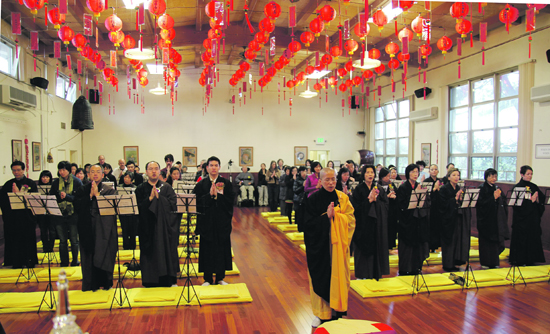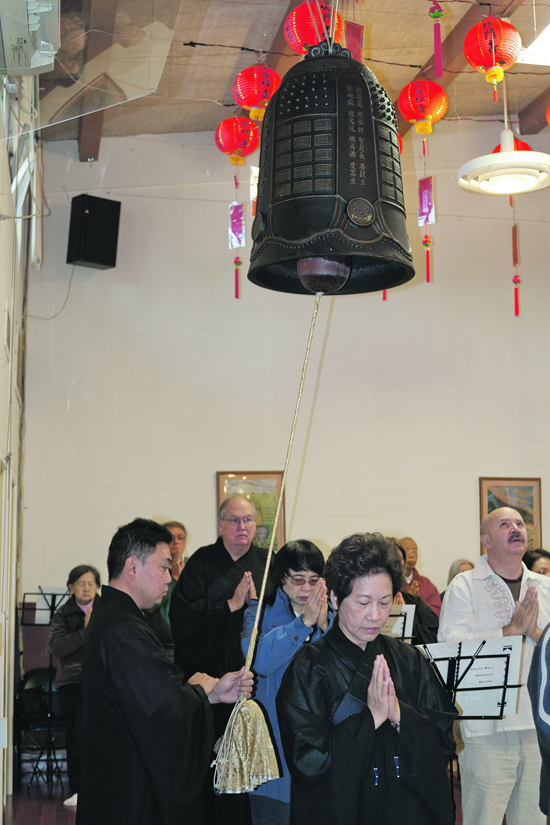| | Published January 18th, 2012
| 新年快樂 (Happy New Year!) Rejoice! It's a Dragon!
| | By Sophie Braccini |  | | Chinese New Year 2011 at Buddha Gate Monastery Photo provided
|
Many Lamorinda households and businesses are making preparations. At Uncle Yu's restaurant in Lafayette, special menus for the holiday eve on January 22nd are being prepared; Catherine and Cheng Liao are shopping for the fish and vegetables they will cook themselves; the home of Ken and Aly Chew is sparkling clean; Stephanie Hom got her red envelopes, and the crisp, new money to go in them, at the Moraga branch of Wells Fargo bank; the children of Zhan Li are expecting to get their own red packages in a few days; Nancy Hom is getting ready for a big family dinner at her father's home in San Francisco; while at the Buddha Gate Monastery in Lafayette, the Abbess and the nuns are gathering all the elements for the ritual offerings of Chinese New Year.
 The Chinese New Year celebrations start with the new moon in the first month of the year and continue for 15 days until the full moon appears. The celebration is believed to have originated thousands of years ago when the people lit firecrackers to scare away Nian, a mythical beast that swallowed people and other animals. According to Chinese astrology, each year is represented by a different animal, and January 23rd will mark the transition from the Year of the Rabbit to the Year of the Dragon.
The Chinese New Year celebrations start with the new moon in the first month of the year and continue for 15 days until the full moon appears. The celebration is believed to have originated thousands of years ago when the people lit firecrackers to scare away Nian, a mythical beast that swallowed people and other animals. According to Chinese astrology, each year is represented by a different animal, and January 23rd will mark the transition from the Year of the Rabbit to the Year of the Dragon.
 "Some people consider the Dragon to be a beneficial animal, it is powerful and magnanimous, some go as far as holding off having babies in order to give birth to a baby-dragon," says Venerable Master Liang Cheng, Abbess of the Buddha Gate Monastery. The Abbess does not care much for the astrological beliefs, however, the Monastery celebrates the Chinese New Year.
"Some people consider the Dragon to be a beneficial animal, it is powerful and magnanimous, some go as far as holding off having babies in order to give birth to a baby-dragon," says Venerable Master Liang Cheng, Abbess of the Buddha Gate Monastery. The Abbess does not care much for the astrological beliefs, however, the Monastery celebrates the Chinese New Year.
 "The New Year is a time of renewal and celebration," she says, "every year about 400 people come to the Monastery on the first day of the Lunar Year to participate in our ceremony and make presents to the Buddha." During the service that starts at 9:30 a.m., the Monastery bell is struck to wake everyone from their delusions. Each participant can also strike the bell as well as make offerings of flowers, lamps or incense to the Buddha for the New Year.
"The New Year is a time of renewal and celebration," she says, "every year about 400 people come to the Monastery on the first day of the Lunar Year to participate in our ceremony and make presents to the Buddha." During the service that starts at 9:30 a.m., the Monastery bell is struck to wake everyone from their delusions. Each participant can also strike the bell as well as make offerings of flowers, lamps or incense to the Buddha for the New Year.
 Zhan Li, the Dean of the School of Economics & Business Administration at Saint Mary's College and a Lamorinda resident, remembers celebrations full of symbolic rituals as they happened in the northeastern Chinese province of HeiLongjiang. "We used to completely clean the house before the New Year," he remembers, "we also wore new clothes starting on the first day of the year, so we wouldn't carry something old in the New Year." Li's understanding is that the tradition was born in a country that was mostly rural, celebrating the coming of longer days and the spring.
Zhan Li, the Dean of the School of Economics & Business Administration at Saint Mary's College and a Lamorinda resident, remembers celebrations full of symbolic rituals as they happened in the northeastern Chinese province of HeiLongjiang. "We used to completely clean the house before the New Year," he remembers, "we also wore new clothes starting on the first day of the year, so we wouldn't carry something old in the New Year." Li's understanding is that the tradition was born in a country that was mostly rural, celebrating the coming of longer days and the spring.
 It's all about sweeping out the old and letting in the new and good luck. So if getting the house clean before the New Year is essential, it is also imperative not to sweep out anything the first day so the good luck stays in. "My wife, who is from Vietnam, stopped me a few years ago when I started to sweep something in the kitchen," recalls Moraga Council Member Ken Chew. He was born in Malaysia, and remembers that everyone got a three-day vacation for the Chinese New Year so they could celebrate and visit friends and family.
It's all about sweeping out the old and letting in the new and good luck. So if getting the house clean before the New Year is essential, it is also imperative not to sweep out anything the first day so the good luck stays in. "My wife, who is from Vietnam, stopped me a few years ago when I started to sweep something in the kitchen," recalls Moraga Council Member Ken Chew. He was born in Malaysia, and remembers that everyone got a three-day vacation for the Chinese New Year so they could celebrate and visit friends and family.
 Nancy Hom, the President of the Friends of the Moraga Library, used to follow the traditions that her parents, Chinese immigrants, respected without always explaining the meaning to her. "For my parents, who immigrated in the 50's, this was very important," she says, "but they didn't explain the meaning to us. I researched and found Good Luck Life: The Essential Guide to Chinese American Celebrations and Culture, by Rosemary Gong, and I learned a lot." The color red for example, that is seen everywhere for the new year, is a sign of good luck because red symbolizes the fire that purifies, the sun, and the lifeblood that the demons fear most. Red is often the color of the lanterns that are lit on the 15th day to symbolize the light and warmth of the coming spring.
Nancy Hom, the President of the Friends of the Moraga Library, used to follow the traditions that her parents, Chinese immigrants, respected without always explaining the meaning to her. "For my parents, who immigrated in the 50's, this was very important," she says, "but they didn't explain the meaning to us. I researched and found Good Luck Life: The Essential Guide to Chinese American Celebrations and Culture, by Rosemary Gong, and I learned a lot." The color red for example, that is seen everywhere for the new year, is a sign of good luck because red symbolizes the fire that purifies, the sun, and the lifeblood that the demons fear most. Red is often the color of the lanterns that are lit on the 15th day to symbolize the light and warmth of the coming spring.
 Some of the traditions incorporate symbolic elements that play on homophonous words. "One of the ritual foods for the New Year is fish," says Li, "because of the sound of the word fish is close to that of the word that means abundance. We also eat tofu, because of the fu character. Displayed upside down it becomes homophonous of the word 'arrive' that symbolizes the arrival of prosperity."
Some of the traditions incorporate symbolic elements that play on homophonous words. "One of the ritual foods for the New Year is fish," says Li, "because of the sound of the word fish is close to that of the word that means abundance. We also eat tofu, because of the fu character. Displayed upside down it becomes homophonous of the word 'arrive' that symbolizes the arrival of prosperity."
 Food and sharing it with family on the eve of the New Year, and with friends and more distant relatives the following days, is a big part of the celebration. "We prefer to cook it ourselves on New Year's Eve," said long-time Lamorinda resident Cheng Liao. In addition to fish and tofu, traditional foods include poultry, long leafy greens and long grain rice or noodles.
Food and sharing it with family on the eve of the New Year, and with friends and more distant relatives the following days, is a big part of the celebration. "We prefer to cook it ourselves on New Year's Eve," said long-time Lamorinda resident Cheng Liao. In addition to fish and tofu, traditional foods include poultry, long leafy greens and long grain rice or noodles.
 "On New Year's day, however, a vegetarian menu is in order as killing animals is not a good idea," warns Stephanie Hom, Moraga's new Administrative Services Director.
"On New Year's day, however, a vegetarian menu is in order as killing animals is not a good idea," warns Stephanie Hom, Moraga's new Administrative Services Director.
 As for the coming Dragon itself, it should be a good omen for the planet since it is a most powerful animal. "But if you are a Dragon yourself (born in 1928, 1940, 1952, 1964, 1976, 1988, 2000), you should wear something red all year long for protection," says Li semi-seriously, "it could be a challenging year for you."
As for the coming Dragon itself, it should be a good omen for the planet since it is a most powerful animal. "But if you are a Dragon yourself (born in 1928, 1940, 1952, 1964, 1976, 1988, 2000), you should wear something red all year long for protection," says Li semi-seriously, "it could be a challenging year for you."
 The famous San Francisco Chinese New Year parade will take place on Saturday, February 11th from 5:15 p.m. to 8:00 p.m.
The famous San Francisco Chinese New Year parade will take place on Saturday, February 11th from 5:15 p.m. to 8:00 p.m.

|
 | | Striking the Monastery bell Photo provided
| | | | | | | | | | | Advertisement
| | |
| | | print story
Before you print this article, please remember that it will remain in our archive for you to visit anytime.
download pdf
(use the pdf document for best printing results!) | | | Comments | | |
| | | | | | | | | | | | | | | | |



